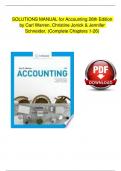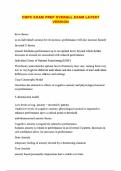SOLUTIONS MANUAL for Accounting 28th Edition
by Carl Warren, Christine Jonick & Jennifer
Schneider. (Complete Chapters 1-26)
, CHAPTER 1
INTRODUCTION TO ACCOUNTING AND BUSINESS
DISCUSSION QUESTIONS
1. Some users of accounting information include managers, employees, investors, creditors,
customers, and the government.
2. The role of accounting is to provide information for managers to use in operating the business.
In addition, accounting provides information to others to use in assessing the economic
performance and condition of the business.
3. The corporate form allows the company to obtain large amounts of resources by issuing stock.
For this reason, most companies that require large investments in property, plant, and equipment
are organized as corporations.
4. No. The business entity concept limits the recording of economic data to transactions directly
affecting the activities of the business. The payment of the interest of $4,500 is a personal
transaction of Josh Reilly and should not be recorded by Dispatch Delivery Service.
5. The land should be recorded at its cost of $167,500 to Reliable Repair Service. This is consistent
with the cost concept.
6. a. No. The offer of $2,000,000 and the increase in the assessed value should not be recognized
in the accounting records because land is recorded on the cost basis.
b. Cash would increase by $2,125,000, land would decrease by $900,000, and owner’s equity
would increase by $1,225,000.
7. An account receivable is a claim against a customer for goods or services sold. An account
payable is an amount owed to a creditor for goods or services purchased. Therefore, an account
receivable in the records of the seller is an account payable in the records of the purchaser.
8. (b) The business realized net income of $91,000 ($679,000 – $588,000).
9. (a) The business incurred a net loss of $75,000 ($640,000 – $715,000).
10. (a) Net income or net loss
(b) Owner’s equity at the end of the period
(c) Cash at the end of the period
1-1
,
, CHAPTER 1 Introduction to Accounting and Business
PRACTICE EXERCISES
PE 1-1A
$597,000. Under the cost concept, the land should be recorded at the cost to Boulder
Repair Service.
PE 1-1B
$369,500. Under the cost concept, the land should be recorded at the cost to
Clementine Repair Service.
PE 1-2A
a. A = L + OE
$518,000 = $165,000 + OE
OE = $353,000
b. A = L + OE
+$86,200 = +$25,000 + OE
OE = +$61,200
OE on December 31, 20Y9 = $353,000 + $61,200
= $414,200
PE 1-2B
a. A = L + OE
$382,000 = $94,000 + OE
OE = $288,000
b. A = L + OE
–$63,000 = +$35,000 + OE
OE = –$98,000
OE on December 31, 20Y9 = $288,000 – $98,000
= $190,000
PE 1-3A
(2) Asset (Accounts Receivable) increases by $22,400;
Owner’s Equity (Delivery Service Fees) increases by $22,400.
(3) Liability (Accounts Payable) decreases by $4,100;
Asset (Cash) decreases by $4,100.
(4) Asset (Cash) increases by $14,700;
Asset (Accounts Receivable) decreases by $14,700.
(5) Asset (Cash) decreases by $1,600;
Owner’s Equity (Terry Young, Drawing) decreases by $1,600.
, CHAPTER 1 Introduction to Accounting and Business
PE 1-3B
(2) Owner’s Equity (Advertising Expense, increases) decreases by $6,750;
Asset (Cash) decreases by $6,750.
(3) Asset (Supplies) increases by $2,920;
Liability (Accounts Payable) increases by $2,920.
(4) Asset (Accounts Receivable) increases by $20,460;
Owner’s Equity (Delivery Service Fees) increases by $20,460.
(5) Asset (Cash) increases by $11,410;
Asset (Accounts Receivable) decreases by $11,410.
PE 1-4A
Up-in-the-Air Travel Service
Income Statement
For the Year Ended April 30, 20Y7
Fees earned $1,870,000
Expenses:
Wages expense $1,115,000
Office expense 343,000
Miscellaneous expense 21,000
Total expenses 1,479,000
Net income $ 391,000
PE 1-4B
Zenith Travel Service
Income Statement
For the Year Ended August 31, 20Y4
Fees earned $899,600
Expenses:
Wages expense $539,800
Office expense 353,800
Miscellaneous expense 14,400
Total expenses 908,000
Net loss $ (8,400)
, CHAPTER 1 Introduction to Accounting and Business
PE 1-5A
Up-in-the-Air Travel Service
Statement of Owner’s Equity
For the Year Ended April 30, 20Y7
Jerome Foley, capital, May 1, 20Y6 $ 876,000
Additional investment by owner during year $ 52,000
Net income for the year 391,000
Withdrawals (34,000)
Increase in owner’s equity 409,000
Jerome Foley, capital, April 30, 20Y7 $1,285,000
PE 1-5B
Zenith Travel Service
Statement of Owner’s Equity
For the Year Ended August 31, 20Y4
Megan Cox, capital, September 1, 20Y3 $456,000
Additional investment by owner during year $ 43,200
Net loss for the year (8,400)
Withdrawals (21,600)
Increase in owner’s equity 13,200
Megan Cox, capital, August 31, 20Y4 $469,200
PE 1-6A
Up-in-the-Air Travel Service
Balance Sheet
April 30, 20Y7
Assets
Cash $ 170,000
Accounts receivable 417,000
Supplies 16,000
Land 772,000
Total assets $1,375,000
Liabilities
Accounts payable $ 90,000
Owner’s Equity
Jerome Foley, capital 1,285,000
Total liabilities and owner’s equity $1,375,000
, CHAPTER 1 Introduction to Accounting and Business
PE 1-6B
Zenith Travel Service
Balance Sheet
August 31, 20Y4
Assets
Cash $ 54,500
Accounts receivable 90,600
Supplies 5,600
Land 372,000
Total assets $522,700
Liabilities
Accounts payable $ 53,500
Owner’s Equity
Megan Cox, capital 469,200
Total liabilities and owner’s equity $522,700
PE 1-7A
Up-in-the-Air Travel Service
Statement of Cash Flows
For the Year Ended April 30, 20Y7
Cash flows from (used for) operating activities:
Cash received from customers $ 1,803,000
Cash paid for operating expenses (1,479,000)
Net cash flows from operating activities $ 324,000
Cash flows from (used for) investing activities:
Cash paid for purchase of land (347,000)
Cash flows from (used for) financing activities:
Cash received from owner as investment $ 52,000
Cash withdrawals by owner (34,000)
Net cash flows from financing activities 18,000
Net decrease in cash $ (5,000)
Cash balance, May 1, 20Y6 175,000
Cash balance, April 30, 20Y7 $ 170,000
, CHAPTER 1 Introduction to Accounting and Business
PE 1-7B
Zenith Travel Service
Statement of Cash Flows
For the Year Ended August 31, 20Y4
Cash flows from (used for) operating activities:
Cash received from customers $ 881,000
Cash paid for operating expenses (895,000)
Net cash flows used for operating activities $(14,000)
Cash flows from (used for) investing activities:
Cash paid for purchase of land (60,000)
Cash flows from (used for) financing activities:
Cash received from owner as investment $ 43,200
Cash withdrawals by owner (21,600)
Net cash flows from financing activities 21,600
Net decrease in cash $(52,400)
Cash balance, September 1, 20Y3 106,900
Cash balance, August 31, 20Y4 $ 54,500
PE 1-8A
a. Dec. 31, Dec. 31,
20Y6 20Y5
Total liabilities……………………………………………… $598,000 $569,900
Total owner’s equity……………………………………… $460,000 $410,000
Ratio of liabilities to owner’s equity…………………… 1.30 * 1.39**
* $598,000 ÷ $460,000
** $569,900 ÷ $410,000
b. Decreased
PE 1-8B
a. Dec. 31, Dec. 31,
20Y6 20Y5
Total liabilities……………………………………………… $4,042,000 $3,096,000
Total owner’s equity……………………………………… $4,300,000 $3,600,000
Ratio of liabilities to owner’s equity…………………… 0.94* 0.86**
* $4,042,000 ÷ $4,300,000
** $3,096,000 ÷ $3,600,000
b. Increased
1-6
© 2021 Cengage Learning, Inc. May not be scanned, copied or duplicated, or posted to a publicly accessible website, in whole or in part.
, CHAPTER 1 Introduction to Accounting and Business
EXERCISES
Ex. 1-1
a. 1. manufacturing 6. service 11. service
2. manufacturing 7. service 12. service
3. manufacturing 8. service 13. manufacturing
4. service 9. manufacturing 14. service
5. merchandise 10. merchandise 15. merchandise
b. The accounting equation is relevant to all of the companies. It serves as the basis
of the accounting information system.
Ex. 1-2
As in many ethics issues, there is no one right answer. Oftentimes, disclosing
only what is legally required may not be enough. In this case, it would be best
for the company’s chief executive officer to disclose both reports to the county
representatives. In doing so, the chief executive officer could point out any flaws
or deficiencies in the fired researcher’s report.
Ex. 1-3
a. 1. K 5. B 9. X
2. G 6. B 10. B
3. B 7. X
4. K 8. G
b. A business transaction is an economic event or condition that directly
changes an entity’s financial condition or results of operations.
Ex. 1-4
Dunkin’s stockholders’ equity: $3,457 – $4,170 = ($713)
Starbucks’ stockholders’ equity: $24,156 – $22,981 = $1,175
Ex. 1-5
Dollar Tree’s stockholders’ equity: $13,501 – $7,858 = $5,643
Target’s stockholders’ equity: $41,290 – $29,993 = $11,297
, CHAPTER 1 Introduction to Accounting and Business
Ex. 1-6
a. $4,474,000 ($633,000 + $3,841,000)
b. $387,500 ($6,124,500 – $5,737,000)
c. $1,232,900 ($1,981,800 – $748,900)
Ex. 1-7
a. $494,000 ($659,000 – $165,000)
b. $555,000 ($494,000 + $88,000 – $27,000)
c. $330,000 ($494,000 – $151,000 – $13,000)
d. $662,000 ($494,000 + $152,000 + $16,000)
e. Net income: $92,000 ($782,000 – $196,000 – $494,000)
Ex. 1-8
a. (1) asset
b. (2) liability
c. (1) asset
d. (3) owner’s equity (revenue)
e. (1) asset
f. (3) owner’s equity (expense)
g. (1) asset
Ex. 1-9
a. Increases assets and increases owner’s equity.
b. Decreases assets and decreases owner’s equity.
c. Increases assets and decreases assets.
d. Increases assets and increases liabilities.
e. Increases assets and increases owner’s equity.
Ex. 1-10
a. (1) Total assets increased $183,000 ($298,000 – $115,000).
(2) No change in liabilities.
(3) Owner’s equity increased $183,000.
b. (1) Total assets decreased $80,000.
(2) Total liabilities decreased $80,000.
(3) No change in owner’s equity.
c. No. It is false that a transaction always affects at least two elements (Assets,
Liabilities, or Owner’s Equity) of the accounting equation. Some transactions
affect only one element of the accounting equation. For example, purchasing
supplies for cash only affects assets.
1-8
© 2021 Cengage Learning, Inc. May not be scanned, copied or duplicated, or posted to a publicly accessible website, in whole or in part.





